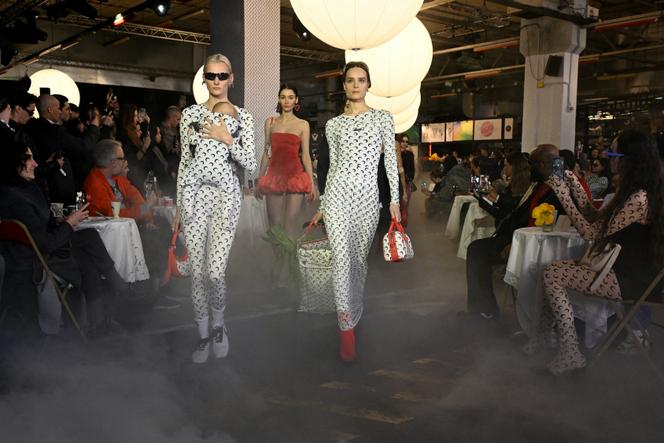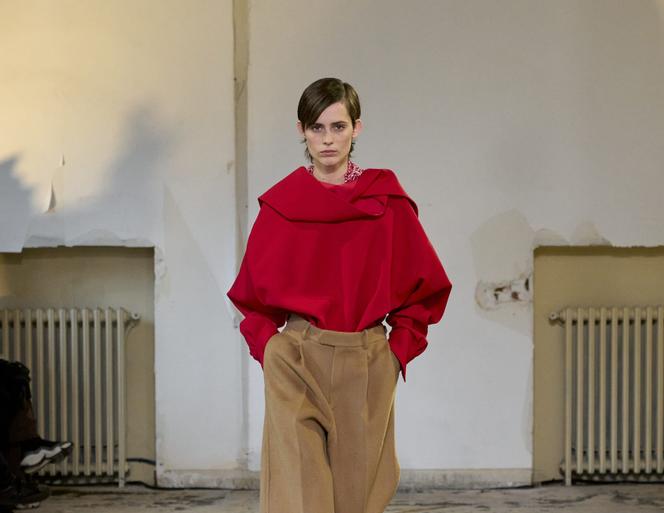


Where are the female fashion designers? It's a debate that has animated industry professionals in recent weeks, following the cascading appointments, at the end of 2023, of male designers to head prestigious brands: Sean McGirr at McQueen, Adrian Appiolaza at Moschino, Alessandro Vigilante at Rochas and Matteo Tamburini at Tod's. And yet, the women are there, and have a lot to say about how clothing shapes the wearer's identity or makes daily life easier. During Women's Fall-Winter 2024-2025 Fashion Week, held in Paris from February 26 to March 5, creative directors vied with each other in imagination and creativity to offer collections mixing commercial viability and fashion fantasies.
"As a woman who designs for women, I want to offer clothes in which you can breathe and feel beautiful," said Marine Serre, seeking the sweet spot between dream and reality. The show took place at Ground Control, a warehouse in the 12th arrondissement of Paris that was converted into a multi-disciplinary living space, where guests could order a coffee or a slice of pizza. "I wanted to recreate the spirit of the market, where people stroll, chat and make connections," said the designer, who had recruited most of her models from the street. Women over 30, muscular, curvaceous, slender or as twins, arrived with their child cradled in a baby carrier or a newspaper under their arm, carrying their shopping bag or pulling a shopping cart with leeks sticking out.
"Showing the beauty of the ordinary is also what I try to do with clothes," Serre said. The French designer offered a complete wardrobe, centered around a few strong ideas: Her signature moon print was scattered over a transparent black fishnet dress, a tight-fitting jumpsuit, a pop-colored twin-set, a bustier worn over a python shirt and a denim work jacket. Basics with a twist (embroidered white shirt, multi-print dress, jeans with yokes) completed this very convincing collection.
At Miu Miu, Miuccia Prada also sought to dress a wide range of women, but she had thought more in terms of age, seeking to define a "vocabulary from childhood to adulthood." Smart jackets stopped above the navel and before the wrists, as if their owner had just experienced a growth spurt; Peter Pan collar dresses were worn with colorful tights and strappy shoes with rounded toes, all elements that make up a prepubescent wardrobe. To illustrate maturity, Prada chose bourgeois signifiers such as a pearl necklace, brooches, long gloves, a handbag and a little black dress.
In between, a few teenage silhouettes passed by in low-waisted skin-tight jeans, tummies in the air and fake fur carelessly placed on their shoulders. Like Serre, Prada chose a wide-ranging cast, from African-American rapper Angel Haze to sexagenarian actress Kristin Scott Thomas to transgender stylist Dara Allen. It was a successful collection, more subtle than previous ones, all miniskirts and exposed panties, but perhaps with less impact.
"I want clothes to be intimate, personal and cherished," explained Louise Trotter, presenting her second collection for Carven. After nine years at Joseph and four at Lacoste, where she successfully injected sporty codes into a city wardrobe, the artistic director explored femininity with restrained elegance. Straight coats with rounded shoulders and men's jackets with exaggerated shoulders give an immediate impression of comfort.
"Nothing is more seductive than a woman who's comfortable in her clothes. It boosts self-confidence," said the designer. This was an idea she pursued with beautifully transparent full skirts, thin-strapped tops and wide pants cut from thick fabric, paired with flat shoes, rounded ballerina shoes or second-skin boots. The color palette, oscillating between mousey gray, chocolate and vermilion, was just right, while opera gloves and imposing but not flashy jewelry sometimes evoked a collection from another time, yet there was nothing anachronistic about this wardrobe designed by Paris's most discreet English designer.

Because Paris Fashion Week also has its share of famous Brits, among them was Stella McCartney, who this season celebrated two female figures: Mother Nature and her own mother, Linda McCartney. By way of introduction, screens broadcast an ecological manifesto under a greenhouse in the Parc André-Citroën: "I am the only mother where it is natural for her to outlive her children. But what will be left of me after you?" asked the voice of actress Olivia Colman. Stella McCartney has always been renowned for her commitment to animals and the environment, and each season continues to expand its list of green textile innovations: crocodile faux leather made from agricultural waste, recyclable aluminum sequins, pesticide-free organic hemp, etc.
Not sure it's enough to save the planet, but McCartney's stylistic proposal, inspired by her mother's wardrobe, was very convincing: Draped, light dresses with long trains contrasted with shouldered suits, worn with nothing underneath. Vapid dresses were given character by their bold colors – white, blood-red – while the more masculine pieces came in old rose or gray beige. Accompanied by Ringo Starr, Paul McCartney, the designer's father, applauded loudly.
Victoria Beckham was another Englishwoman at Paris Fashion Week, with a sizeable family fan club: her husband, David, an ex-football star, and their children. In a rather cheerful mood despite her broken foot and crutches, this season she sought to celebrate the feminine silhouette. To achieve this, the emphasis was on pants, whose legs seemed endless and as if floating around the body. "These very long pants are a novelty for the brand. They really lengthen the leg thanks to their low rise. I really like to use sewing tricks to create an illusion," said the designer.
The illusion continued in this collection, where large, shouldered jackets were held in the back by a simple strap threaded around the nape of the neck; knit sweaters had two collars; and draped, sheer dresses were fastened with metal clips resembling hangers. The collars of coats and small leather jackets, set high on the neck, underlined the idea of an elongated silhouette. Despite its experimental nature, the ensemble was highly wearable.
Chitose Abe, Sacai's founder and artistic director, also sought to take clothes out of their ordinary context: On the catwalk, we saw zip-up jackets with patch pockets, long thick knit sweaters with tulle inlays, pea coats with ruffled hems and large men's jackets. But on closer inspection, each of the 46 silhouettes presented was in fact a dress that mixed and merged elements from other garments.
"Fashion is the armor to survive the reality of everyday life," said the designer, quoting New York street photographer and fashion historian Bill Cunningham (1929-2016), who inspired this collection. The Japanese designer proved once again that, when it comes to accumulating, deconstructing or judiciously tying fabrics together, she has no equal.
Whether they are exploring fashion as a creative laboratory, as Abe does, or see it as a means of spreading joy, as Serre does, women designers are here to stay. And we can count on them to renew this still very masculine sector.
Translation of an original article published in French on lemonde.fr; the publisher may only be liable for the French version.
